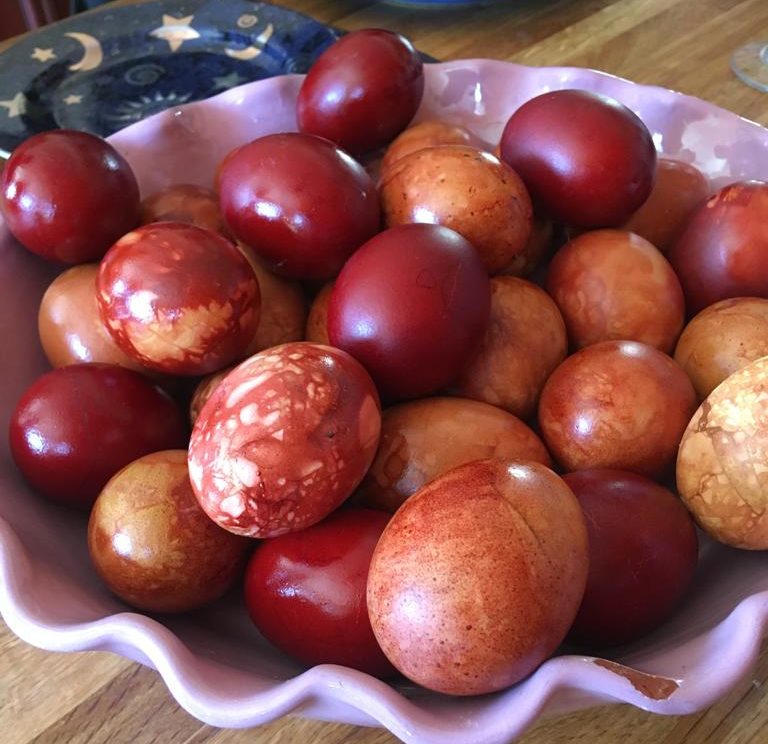At Easter in Greece, it’s customary to dye Easter eggs red. Red symbolizes the blood of Christ. Eggs are usually dyed on Holy Thursday before Easter. On Easter Sunday, children and adults enjoy “cracking” their eggs against each other while celebrating the resurrection of Christ.
In this article, Evi invites you to discover :
How to dye Easter eggs red?
Commercial ready-to-use solutions: Practical but chemical

The eggs already red
Well, this is really the “for dummies” solution, or for those who really don’t have the time. The quality of the eggs is generally mediocre, and the colorants are edible but not necessarily very natural.
Kits for dyeing Easter eggs red
There are two types of commercially available dyes: hot and cold.
- the first method involves cooking the eggs in water already containing the colorant and vinegar.
- the second involves cooking the eggs in pure water. They are then immersed in a water bath containing colorant and vinegar.
In both cases, vinegar acts as a fixative. Cooking time is that recommended for a hard-boiled egg, about 12 minutes. Then we pass each egg through a piece of oiled cloth, to give it a nice shine. Small stickers or decorations can also be stuck on.
What ingredients use to naturally dye Easter eggs red?

Garance root: Cornelius Gloria [CC BY-SA 3.0]
Onion peel: Pixabay
Myth and reality
You’ll often find natural dyeing tips using vegetable juices: spinach for green, red cabbage for blue-violet, beet for red… (Editor’s note: Evi has tested them all). Unfortunately, the result is disappointing, as the color is too pale.
Natural and effective colorants
- First of all, the root of the Rubia Tinctorum plant is actually Garance root or rose madder.
. It yields a powerful, indelible brick-red dye once used for fabrics, in Greek it’s called “ριζάρι” (rizari) . In Athens, you can find it in the spice stores on Evripidiou Street near the central market. You can also find them on the Amazon website. - Then the onion peel. The latter gives a brick-brown color to brown eggs and a yellow color to white eggs.
How to dye with natural colorant?
The best way is to combine the various techniques listed below, to achieve a graphic, multicolored result!
For brick-red madder-dyed eggs
- Pour boiling water over 4-5 tablespoons madder in a bowl, leave to soak for 2 hours.
- Then lay the eggs flat in a saucepan, without overlapping them, add the madder and water, and top up with cold water so that the eggs are well covered.
- Add 3-4 tablespoons vinegar and 1 tablespoon coarse salt, then bring to the boil and cook for 12 minutes.
- Remove from the pan, allow the eggs to cool, then oil them with a cloth to give them a glossy finish.
- The same water can be used to make several dye baths.
For the onion-peel marbled eggs
- Cut out approx. 10cm lengths of old nylon tights.
- Wrap each egg irregularly with onion skins. The whole egg must be covered.
- Place the egg in the piece of pantyhose, tying a knot or two to prevent the peel from moving.
- Place the eggs in a pan of cold water.
- Add 3-4 tablespoons vinegar and 1 tablespoon coarse salt.
- Put on the heat and count 12 minutes from the time the water starts to boil. The eggs should be laid in a single layer and not too tightly, but they should take up all the space at the bottom of the pan, to avoid breaking.
- To enhance the color, add the rest of the peelings in bulk to the water. You can mix brown and white eggs to obtain a variety of colors.
- When the eggs are cooked, add cold water to the pan, gently remove them, removing the bottoms and peelings. Rinse to remove all waste, then wipe eggs with an oiled cloth.
There you go! The eggs are ready, all that’s left is to put them in a dish and wait for Easter Day to eat them.
Tips and tricks
- Eggs can be stored in a cool place for about 2 weeks.
- To avoid breakage, remember to take the eggs out of the fridge 1 hour beforehand, so that they are at room temperature, and place a flat sponge (like a dishcloth) at the bottom of the pan.
- You can also add two tablespoons of coarse salt to the cooking water.
Tsougrisma or the art of “tapping” Easter eggs?
On Easter Day, each guest chooses his or her own egg and taps it against the others’. The eggs are held vertically and tapped tip to tip and butt to butt. In reality, the one holding the bottom egg remains motionless, while the one with the top egg taps vertically. The one whose egg breaks all the others is the winner.
At the moment of typing, the ritual formula is pronounced: ” Χριστός ανέστη” (Christos anesti) and the other person responds: “Αληθώςανέστη”. (Alithos anesti). Which means: “Christ is risen” and “He is truly risen”.
Happy Easter!
Thanks to Evi Siougari-Parmantier for these explanations.




